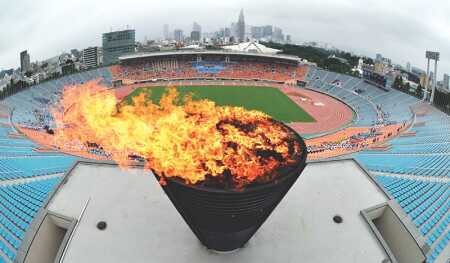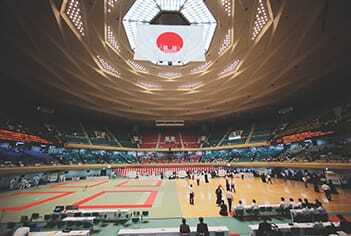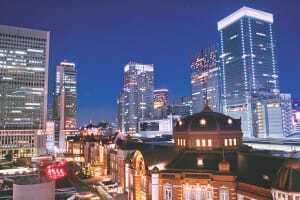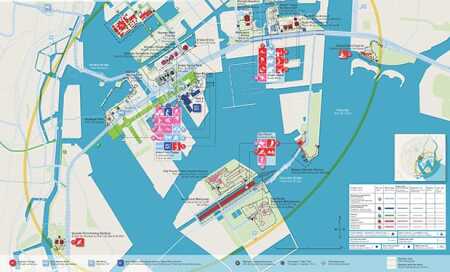Japan’s sprawling capital city elected a new governor, Yoichi Masuzoe, in February. One of his most important tasks: preparations for a successful 2020 Olympics that stays within its budget, boosts the economy, and leaves a legacy for Tokyo.
Tokyo once before hosted a Summer Olympics—in 1964, when massive infrastructure investment helped underpin Japan’s “economic miracle.” The first bullet trains started service, highways were completed, and ports were improved to help Japanese nationals and visitors get around. That infrastructure still exists, so what can preparation for the Olympics do to help Tokyo this time?
“Infrastructure is aging and deteriorating,” says Naoto Aiba, executive vice president of Mitsubishi Estate. “It should be renewed. That can help lead to more attention for Tokyo. The Olympics should act as a trigger to get the ball rolling.”
Moving the city into the 21st century will be key to a successful Games, said many participants at the ULI Japan Winter Conference, held in December. There is a sense of the inevitable about the changes coming to Japan, participants said. Demographic trends mean companies will need to look outside Japan to survive, and foreign money and overseas customers are needed to keep up the momentum of Abenomics—the economic policies of Japanese Prime Minister Shinzo Abe.
The challenge is to tweak rather than revolutionize the cityscape, said conference participants—to let people see that Tokyo is a city that the modern traveler should visit. “The 1964 Olympics were to show Japan to the world,” said Takeo Nishitani, chair of public relations company Weber Shandwick’s Japan office. “For the next Olympics, what is important is to show that under globalization and modernization there is something to see in Japan.”
Raising High Standards
Toyko’s basic plan for the Olympics is to combine legacy buildings with new facilities to house athletes and host events. Members of the Olympic bid committee say their plan will make sure “journey times for athletes, officials, and all members of the Olympic family” are minimized, while “the experience of all those touched by the unique spirit of the Games” is maximized.
Infrastructure efficiency will be improved and work will be done to get everyone in the city involved in the Games, but the plan is for these efforts to be conducted in a way that minimizes costs.
Old venues such as the Olympic Stadium will be rebuilt at the heart of a Heritage Zone, where most of the sporting events for the 1964 Olympics were held. This mostly developed area surrounding the Imperial Palace includes venues already completed; most of the expenses will involve day-to-day running of events and refurbishments. Ten new facilities will be built in the Tokyo Bay Zone, an area centered on the reclaimed land of Odaiba that will include temporary facilities and a new venue for swimming competitions. The Olympic Village will be in the nearby Harumi area of Tokyo Bay between the two Olympic zones.
Plans also call for three new roads—the Tokyo Outer Loop, the Tokyo Metropolitan Expressway Central Loop, and the National Capital Regional Central Loop—to be completed in time for the event. And to reinforce transportation efficiency, airport, rail, and port infrastructure will be bolstered.
“The government has put together a vision for 2020,” says Eiji Enomoto, executive officer at Nomura Real Estate Development. “Targets include promoting safety; raising competitiveness by connecting land, sea, and air routes; and increasing industrial power and the city’s attractiveness.”
The cost of the improvements is estimated at $5 billion to $6 billion. The reward for Japan, according to the Tokyo metropolitan government, stands at around $30 billion in basic stimulus, and a lot more when side effects, such as tourism, increased consumer spending, and capital spending due to the Games, are included.
Infrastructure, however, will be the simplest of tasks for the Games organizers. More difficult, says Takeo Hirata, who is advising the government on its Olympic plans: “We need to change people’s mind-sets so we [Japanese] are considered global citizens by the international community. We need to make sure there is internationalization in the buildup to the Games.”
What’s Wrong?
Recent Olympics have demonstrated the benefits, even if temporary, that hosting the Games can have. Beijing 2008 served as a “coming-out party” for China as a new power on the world stage. London 2012 represented something different: the Games showed Britain as a modern and diverse country that could pull together to support sports professionals at home while welcoming visitors from all over the world. Can Tokyo manage something similar? It faces an uphill struggle.
Companies are going to have to change their perspectives in order to adapt to the globalizing economic environment, said conference speakers. And the city itself—vast, populous, and often perceived to be alienating—will have to do more to foster the sort of hospitality that encourages repeat visits, said conference speakers. Japan last year attracted more than 10 million visitors for the first time, despite being the world’s third-largest economy. Speakers at the conference said cheap and simple steps, such as simplifying signs and making train services more user friendly, could help the country attract return visitors.
In the private sector, companies such as Lixil, a Japanese home goods maker, are working to internationalize. “We, and also the next generation, will conduct economic activity in a greater area because of the Olympics and trade negotiations,” Yoshiaki Fujimori, Lixil president and chief executive officer, said in a speech at the conference.
For Fujimori, who learned his trade at General Electric in Japan and the United States, companies in Japan need to do more to open up to outside influences and maximize the potential of in-house talent. “It took GE 40 years to become a global player,” Fujimori said. “How long will it take Lixil? First, we need to change our culture. It is still traditional and dominated by males. We are now looking to respect diversity, provide equal opportunity, and implement meritocracy.”
This outlook in Japan is more revolutionary than it sounds. The country placed 101st among 135 in World Economic Forum 2012 rankings on gender equality, behind such nations as Botswana, Tajikistan, and El Salvador. Swiss business school IMD ranks Japan 29th out of 55 countries in competitiveness, pointing out that “few Japanese companies are genuinely global.”
Turning around the corporate situation would have cultural as well as economic benefits. “We need to change the male-dominant culture in Japan so that when people come to Japan they do not think women are disrespected,” Fujimori said.
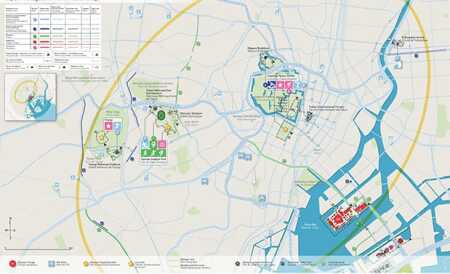
This map of the Tokyo 2020 Heritage Zone shows the location (from left) of the Yoyogi National Stadium; the Olympic Stadium; where track and field events will take place; the Nippon Budokan, where the judo competition will be held; and the Olympic Village (lower right), which will house the athletes.
Citywide Brand
Beyond corporate culture, Tokyo has plenty of other issues to address, conference participants said. “People have the impression that prices are high in Tokyo, but then they come and realize they are not,” said Tom Sawayanagi, managing director of Jones Lang LaSalle Hotels. “How can we change this perception?”
Nishitani argued that Tokyo needs to modernize its city brand, which he described as a combination of such tangibles as infrastructure and buildings, and the intangible of local culture. “Encounters with Japanese are just as important as monuments and history,” he said.
“The key is hospitality,” he added. “We have to rethink this. We do not want to do hospitality by the numbers, but more something of a mind-set. Tokyo subway signs and those on the roads are very poor. The transport network is exceptionally complicated. Those arriving at the airport encounter poor handwriting and announcements telling them to go to quarantine if they have diarrhea. What must they think? How can we change these things and achieve real hospitality? This is what we need to work on.”
The two speakers agreed that the city experience leaves room for improvement. “Minor initiatives can help improve hospitality,” said Sawayanagi. Simpler train maps and clearer English-language signs were among his suggestions. Nishitani, meanwhile, sees the consumer experience as detrimental to hospitality. “Vending machines clutter scenic streets, and consumers can use them without having to communicate with anybody,” he said.
For Nishitani and Sawayanagi, development of Tokyo as a city that provides more opportunities to communicate and that is easier to navigate would have a lasting impact and serve as a long-term legacy for Olympics.
Fiscal Health
Abe’s policies have bolstered the national economy and left Tokyo well positioned economically for the Games, participants said. “We didn’t expect Abenomics’ impact to be as good as this,” said Fujimori. His company’s results last year returned to levels seen before the bankruptcy of Lehman Brothers in 2008. Similar stories are told across corporate Japan and have created the conditions required for broad acceptance of a 3 percent consumption tax hike scheduled to take effect in April.
That increase is being implemented by the government to try to reign in Japan’s debt, which stands at more than 200 percent of the country’s gross domestic product. Bringing the debt down before it reaches unsustainable levels is high on the government’s agenda, and the coming Olympics helped gain approval for the tax increase. “Before the Olympics is a good time for the consumption tax hike,” said Takahiro Uchida, head of investments in Japan at GE Capital Real Estate. He argued that the economic boost from the Games would offset any medium-term downturn created by the tax increase. Hiroyuki Katsuno, chief operating officer of Simplex Investments, agreed, adding, “Most Japanese are understanding of the need for a tax hike.”
So the real issue for Japan may be solving problems beyond the economy. But what can investors do to help Tokyo realize its vision for the Games? In the real estate market, there is plenty of room for investment in more modern infrastructure. John Zehner, global head of capital markets at LaSalle Investment, said his company is focusing on logistics. “The impact of Abenomics has improved the overall environment here, and our view has not changed that logistics is a very attractive investment strategy,” he said.
For those going down the more traditional real estate path, Nishitani has a request. “All these developed places in Tokyo are not connected to each other,” he said. “There are interesting spots, but nothing in between. Developers look to save costs on space. Too much focus is put on developing basements, but we need to develop open spaces. As we go higher, I hope we will provide more open spaces to the public.”
Japan has the ideas of how it can make the Tokyo Olympics work. Now comes the difficult part: implementing them.
Richard Smart is a Tokyo-based freelance journalist who writes on business, society, and the economy.

